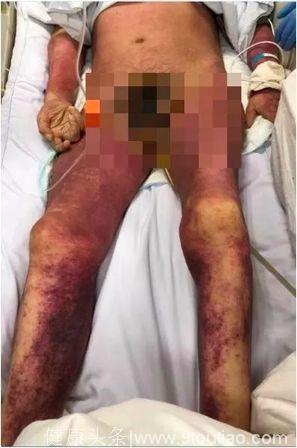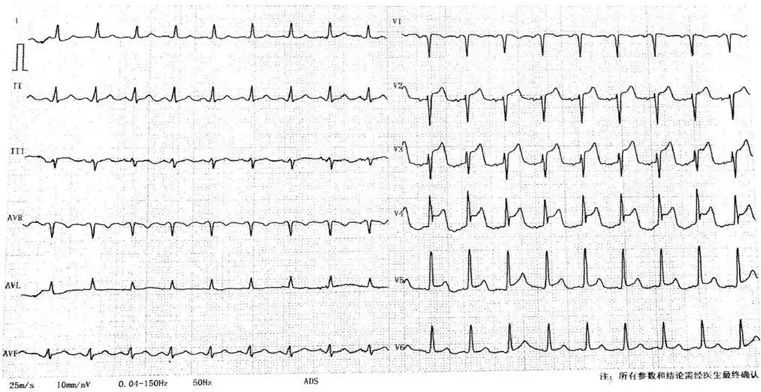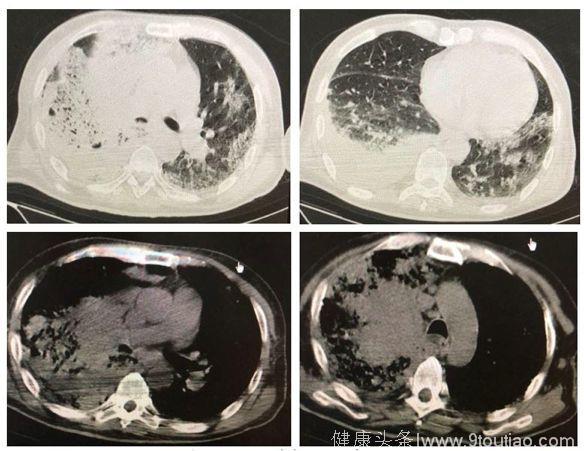久病成医?患者自行联用靶向药身亡!
一位意识不清,胸闷憋气,全身皮肤出现大面积暗紫红色瘀斑的患者来到了急诊科。询问病史发现,既往有肺腺癌脑部转移,术后恢复良好却未能遵医嘱予以正规的抗肿瘤治疗,复查后发现病灶进展,竟在微信群聊病友的建议下自行设定所谓的「双靶」方案!
病例介绍
基本信息
患者男,60岁。
主诉
因「 间歇性发热伴意识不清、嗜睡和胸闷憋气症状,躯干四肢出现大面积片状红色瘀斑 」于我院就诊。
病史及查体
三年前因「 右侧肢体体力减弱 1 月伴加重 1 周 」行右侧中央区脑占位性病变切除术,术后病理提示右肺腺癌脑转移,基因检测未见明确靶点,术后恢复良好。出院后患者未遵医嘱予以正规抗肿瘤治疗。
2018 年 5 月复查右肺部肿瘤病灶较前明显进展,遂于 6 月经微信群聊中的病友介绍开始口服厄洛替尼和卡博替尼,自行设定所谓的「 双靶 」方案:每3天为一个服药周期,共3个周期。厄洛替尼 150 mg一天一次,卡博替尼 50 mg 每 2 - 3 天一次。
服药后第 6 天四肢出现少量散发红色皮疹,尤以下肢多见,未重视,后继续口服。服药第 9 天出现间歇性发热,体温最高 39.7 ℃,伴意识不清、嗜睡和胸闷憋气症状,躯干四肢出现大面积片状红色瘀斑。查体见全身皮肤可见大面积暗紫红色瘀斑,压之不褪色,双上肢伸侧少量针尖样大小淡黄色脓疱。双侧瞳孔直接和间接对光反射迟钝,右肺上叶未闻及呼吸音,双肺下叶听诊可闻及双相湿罗音。双下肢可及凹陷性水肿。
辅助检查
血常规白细胞计数 45.56 * 109 /L,中性粒细胞百分比 0.91。血生化:天冬氨酸氨基转移酶 104.6 U/L,γ-谷氨酰转肽酶 77.5 U/L,尿素 38.97 mmol/L,肌酐 216.4 umol/L,肌酸激酶 1295 U/L, 肌酸激酶同工酶 64.9 ng/ml,乳酸脱氢酶 1393 U/L,肌红蛋白 944.9 ng/ml,全血肌钙蛋白 19.8 ng/ml,脑利钠肽前体(Pro BNP)10490 pg/ml, D-二聚体 10.86 ug/ml,白细胞介素-6(IL-6)1278 pg/ml,降钙素原 20.23 ng/ml。动脉血气示 Ⅰ 型呼衰合并代谢性酸中毒。

累及四肢的广泛皮损

心电图:窦性心动过速,V2、V3、V4、V5广泛ST段弓背型抬高。既往两种靶向药物都有心脏毒性的报道,尚不能排除靶向药物嫌疑。

胸部CT平扫:右肺上叶中央型肺癌并纵膈淋巴结转移,双肺广泛炎性病变,右侧胸腔积液伴下肺膨胀不全。
入院诊断
- 发热伴全身瘀斑原因待查;
- 急性(前壁)心肌梗死 心力衰竭(Killip Ⅳ 级);
- 紫癜型药疹;
- 右肺腺癌(cT4NxM1c,Ⅳ 期) 脑转移灶切除术后,肝转移,全身多发淋巴结转移,右侧胸腔积液伴下肺膨胀不全;
- 肺部感染伴间质性肺炎不除外;
- Ⅰ 型呼衰合并代谢性酸中毒;
- 急性肝肾功能不全;
- 高血压病
因患者家属拒绝有创和侵入性操作与救治手段,故入院后给予积极对症支持治疗,但效果不明显。患者终因呼吸循环衰竭于入院后第 2 日死亡。
讨论
患者既往一般身体状况良好,仅长期口服降压药,无皮肤病史,也未明确有心、肝和肾疾患,无法用单纯的疾病进展予以合理解释其短时间内大面积皮损和肝肾功能异常的现象,故认为与此次未遵医嘱用药有很大关联性。
此外,双肺的广泛炎性病变尚不能排除靶向药物所致间质性肺病和(或)合并感染的可能。
既往厄洛替尼用于晚期 EGFR 突变阳性的非小细胞肺癌(NSCLC)一线治疗。最常见的不良反应是皮疹和腹泻,多数的皮疹发生于服药 2 周内。既往已有大疱性,水泡性和剥脱性皮肤改变的报道。卡博替尼是多种络氨酸激酶受体的拮抗剂,同时也是多靶点作用的分子靶向药,具有发挥肿瘤、减少转移并抑制肿瘤血管新生等作用,被称为「抗癌多面手」。在厄洛替尼联合卡博替尼的Ⅰb / Ⅱ 期临床试验(NCT00596648)明确了双靶治疗的规范服用方法:卡博替尼 100 mg 和厄洛替尼 50 mg qd 或卡博替尼 40 mg 和厄洛替尼 150 mg qd 的模式。
如今,越来越多的靶向药物研发成功和上市,而在上市前的临床试验中难以全面观察到或明确知晓其不良反应和毒性反应,其会随着临床应用逐步发现。
综上所述,虽然肿瘤患者本人和家属普遍有焦虑、紧张、无助和不知所措的心情,这我们都能理解,但千万不能将此心情转化为有病乱投医或者百病之后自己就是江湖郎中的具体行动,更不能听「别人的经验」。作为医生,我们应告诫患者,对于任何抗肿瘤的治疗应充分沟通,并了解在治疗过程中可能出现的风险和预防措施。不可因病随意、盲目的使用靶向药物,毕竟我们的身体不是大试管,可以随意配伍试剂观察药物的反应效果。
对于上述案例,你怎么看?临床工作中,你还经历过哪些让人哭笑不得的患者故事?欢迎在评论区留言交流。
作者:中国人民解放军总医院肿瘤内科 李涛 胡毅
编辑:江小兔 晶晶王
图片来源:shutterstock
参考文献:
1. BoeckS, Hausmann A, Reibke R, et al. Severe lung and skin toxicity during treatmentwith gemcitabine and erlotinib for metastatic pancreatic cancer.[J].Anti-cancer drugs, 2007, 18(9):1109-1111.
2. PérezsolerR, Chachoua A, Hammond L A, et al. Determinants of tumor response and survivalwith erlotinib in patients with non--small-cell lung cancer.[J]. Journal ofClinical Oncology, 2004, 22(16):3238-3247.
3. 特罗凯-盐酸厄洛替尼片药品说明书.2006年版.上海罗氏制药有限公司.
4. 宗晓福,谢林艳,陆娇,王慧,李田,黄茂,周林福.厄洛替尼致重度皮疹和致死性间质性肺病一例临床分析[J].中国呼吸与危重监护杂志,2014,13(03):273-276.
5. Jost M, KariC, Rodeck U. The EGF receptor - an essential regulator of multiple epidermalfunctions.[J]. European Journal of Dermatology, 2000, 10(7):505-510.
6. SaifM,Merikas I,Tsimboukis S,et al. Erlotinib –induced skin rash.Pathogenesis, clinicalsignifi cancer and management in pancreatic cancer patients[J].Pancreas, 2008,9(3):267-274.
7. BoeckS, Hausmann A, Reibke R, et al. Severe lung and skin toxicity during treatmentwith gemcitabine and erlotinib for metastatic pancreatic cancer.Anti-Cancer Drugs,2007, 18(9): 1109-1111.
8. 丁燕,刘谦,南娟,周清华.厄洛替尼引起非小细胞肺癌患者发生皮疹的病理机制、临床意义及其治疗[J].中国肺癌杂志,2009,12(12):1330-1336.
9. 陈晓霞,孙辉,张玲,孙宇萍,周彩存.盐酸厄洛替尼所致皮疹的免疫机制研究[J].肿瘤,2011,31(6):542-545.
10. WackerB, Nagrani T, Weinberg J, et al. Correlation between development of rash andefficacy in patients treated with the epidermal growth factor receptor tyrosinekinase inhibitor erlotinib in two large phase III studies[J]. Clinical CancerResearch An Official Journal of the American Association for Cancer Research,2007, 13(13):3913-3921.
11. 黄逸生,杨衿记,杨艳,黄玉娟,廖日强,吴一龙.皮疹与厄洛替尼治疗晚期非小细胞肺癌疗效相关性研究[J].中国癌症杂志,2009,19(9):689-692.
12. 崔迪,崔俊昌,陈良安,解立新.厄洛替尼单药治疗非小细胞肺癌继发重症肺纤维化一例[J].中华内科杂志,2008,47(2):151.
13. YakesF M, Chen J, Tan J, et al. Cabozantinib (XL184), a Novel MET and VEGFR2 Inhibitor,Simultaneously Suppresses Metastasis, Angiogenesis, and Tumor Growth[J]. MolecularCancer Therapeutics, 2011, 10(12): 2298 -2308.
14. Viola D, Cappagli V, Elisei R.Cabozantinib (XL184) for the treatment of locally advanced or metastaticprogressive medullary thyroid cancer[J]. Future Oncology, 2013, 9(8):1083-1092.
15. BentzienF, Zuzow M, Heald N, et al. In vitro and in vivo activity of cabozantinib(XL184), an inhibitor of RET, MET, and VEGFR2, in a model of medullary thyroidcancer.[J]. Thyroid Official Journal of the American Thyroid Association, 2013,23(12):1569-1577.
16. EngelmanJA; Zejnullahu K; Mitsudomi T; Song Y; Hyland C; Park JO; Lindeman N; Gale CM;Zhao X; Christensen J; Kosaka T; Holmes AJ; Rogers AM; Cappuzzo F; Mok T; LeeC; Johnson BE; Cantley LC; Jänne PA. MET Amplification Leads to GefitinibResistance in Lung Cancer by Activating ERBB3 Signaling[J]. Science, 2007,316(5827):1039-1043.
17. JackmanD, Pao W, Riely G J, et al. Clinical definition of acquired resistance toepidermal growth factor receptor tyrosine kinase inhibitors in non-small-celllung cancer.[J]. Journal of Clinical Oncology, 2010, 28(2):357-360.
18. Rosell R, Carcereny E, Gervais R, et al. Erlotinib versus standard chemotherapyas first-line treatment for European patients with advanced EGFRmutation-positive non-small-cell lung cancer (EURTAC): a multicentre,open-label, randomised phase 3 trial.[J]. Lancet Oncology, 2012, 13(3):239-246.
19. SetoT, Kato T, Nishio M, et al. Erlotinib alone or with bevacizumab as first-linetherapy in patients with advanced non-squamous non-small-cell lung cancerharbouring EGFR mutations (JO25567): an open-label, randomised, multicentre,phase 2 study.[J]. Lancet Oncology, 2014, 15(11):1236.
20. BustinF, Flynn P, Hart L, et al. Efficacy of bevacizumab plus erlotinib versuserlotinib alone in advanced non-small-cell lung cancer after failure ofstandard first-line chemotherapy (BeTa): a double-blind, placebo-controlled,phase 3 trial[J]. Lancet, 2011, 377(9780):1846-1854.
21. YanoS, Wang W, Li Q, et al. Hepatocyte growth factor induces gefitinib resistanceof lung adenocarcinoma with epidermal growth factor receptor-activating mutations.[J].CancerResearch, 2008, 68 (22):9479 - 9487.
22. TangZ, Du R, Jiang S, et al. Dual MET–EGFR combinatorial inhibition againstT790M-EGFR-mediated erlotinib-resistant lung cancer[J]. British Journal ofCancer, 2008, 99(6):911-922.
23. MasuyaD, Huang C, Liu D, et al. Masuya D, Huang C, Liu D, Nakashima T, Kameyama K,Haba R, Ueno M, Yokomise HThe tumour-stromal interaction between intratumoralc-Met and stromal hepatocyte growth factor associated with tumour growth andprognosis in non-small-cell lung cancer patients[J]. British Journal of Cancer,2004, 90(8):1555-1562.
24. Neal J W, Dahlberg S E, Wakelee H A, et al. Erlotinib,cabozantinib, or erlotinib plus cabozantinib as second- or third-line treatmentof patients withEGFRwild-type advanced non-small cell lung cancer (ECOG-ACRIN1512): a phase 2 randomised controlled trial:[J]. Lancet Oncology, 2016,17(12):1661-1671.
25. WakeleeH A, Gettinger S, Engelman J, et al. A phase Ib/II study of cabozantinib(XL184) with or without erlotinib in patients with non-small cell lungcancer[J]. Cancer Chemotherapy & Pharmacology, 2017, 79(5):1-10.